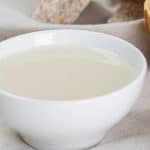Quick summary: Most available tamarind substitutes are lemon or orange juice with brown sugar, pomegranate molasses, or Worcestershire sauce. But you can try other options like mango chutney, dry white wine, or vinegar with brown sugar.
Tamarind pulp is common in Southeast Asian cooking, Mexican, Indian, Middle Eastern, and Caribbean cuisine. You might be more familiar with tamarind paste from your local grocery store than with the fruit itself.
Either way, if your recipe calls for the perfect sweet-and-sour flavor of tamarind and you don’t have any, we’re here to help.
You’ll find a long list of tamarind alternatives below, and we’re sure you already have some of these in your pantry. We’ll also give you some tips to get the best flavor balance for your dish.
What Is Tamarind?
A little unusual for a fruit, tamarind grows in the shape of pods on tamarind trees. If you’ve never seen them before, you’d likely expect to find dry seeds inside instead of the surprisingly deliciously sticky pulp.
The brown or reddish-brown pods contain anything between six to 12 seeds depending on the variety of tamarind tree.
The interior of the pod has a date-like texture. Tamarind pods have a distinctive tang with an underlying sweetness. The sticky fruits are crushed to make the paste or a juice concentrate.
Tamarind is used in chutneys, drinks, sauces, and dressings. It is also used in soups, stews, curry, jams, and even in desserts.
Its acidity and stickiness make it ideal for marinades. While the acid helps to tenderize the meat, the sticky sweetness makes a great glaze.
How to Choose a Tamarind Substitute
When choosing a tamarind paste substitute you need to balance sweet and sour flavors as well as a little acidity.
Since this is rarely possible to achieve with just one ingredient, most alternatives include a blend of two or three ingredients.
Consider the consistency of your substitute. When thin liquids are used in large quantities you may have to cut down on liquid elsewhere in your recipe to prevent the overall consistency from becoming too runny.
Best Tamarind Substitutes
1. Worcestershire Sauce
Worcestershire sauce is a British condiment that is easily available in most grocery stores. The thin, dark brown liquid has a complex flavor with a vinegary background.
Besides vinegar, it also contains spices, anchovies, molasses, onion, and garlic. Despite having anchovies in the ingredients list, it doesn’t have any fishy flavor whatsoever. The ingredients are fermented together to produce a unique complexity.
One major difference when using Worcestershire sauce as a replacement is that the consistency is much thinner.
If your recipe calls for a small amount, this will work in a straight swap. However, if your recipe requires more than a tablespoon or two, you will have to make a Worcestershire sauce blend with other ingredients to get the same sticky consistency.
Mix the following ingredients together well so that the sugar has dissolved. Use the blend as a replacement in equal quantities. Store any leftovers in the fridge for your next cook.
- ¼ cup Tomato paste
- 1.5 tablespoons Worcestershire sauce
- 1.5 tablespoons lemon or lime juice (you can also use apple cider vinegar)
- 1 tablespoon brown sugar
If you find the consistency too thick, mix in just one tablespoon of water
Worcestershire sauce as well as the Worcestershire sauce blend are great replacements in meat and veggie marinades, glazes, curry, and stews.
They are not suitable for sweet dishes. We suggest you move on to the next alternative if you need a substitute that can be used in both desserts and savory dishes.
Here’s all you must know on Worcestershire sauce shelf life and how to tell if it’s spoiled.
2. Pomegranate Molasses
Pomegranate molasses is the juice of pomegranate fruit reduced into a more concentrated and thick consistency. It has a tart flavor with hints of sweetness.
Also known as pomegranate syrup, it is commonly used in Middle Eastern cuisine in meat, fish, chicken or bean dishes, stews, and as the vinegar component in salad dressing. It can also be used in desserts, drizzled over pancakes, rice pudding, or ice cream.
If you have pomegranates at home, you can even make your own syrup by heating two cups of pomegranate juice with ¼ cup of lemon juice and a ¼ cup of white sugar.
Simmer the ingredients together on low to medium heat until the liquid has reduced by half to a thick syrup consistency.
Whether homemade or store-bought, you can use it in equal quantities as a replacement.
3. Fresh Lemon Juice and Brown Sugar
This substitute is incredibly simple and easy to put together. It doesn’t offer the same color or complex flavor but it does bring the all-important sweet and sour characteristics.
It is suitable to use in smaller quantities only since the liquid is thin and lacks the stickiness of a paste.
Mix equal parts of lemon juice and brown sugar so that the brown sugar dissolves completely. You don’t want to be biting on sugar granules!
Use your blend as a replacement measure for measure. For example, if your recipe calls for 2 tablespoons of tamarind paste, mix together one tablespoon of lemon juice and one tablespoon of brown sugar as your replacement.
Although brown sugar is suggested due to its caramel undertone and richer color, you can also use white sugar, honey, or agave instead.
Honey or agave will give you a slightly stickier texture. If you don’t have lemons, you can alternatively use lime juice and brown sugar.
4. Fresh Orange Juice and Brown Sugar
If you have fresh oranges on hand (or freshly squeezed juice) combine equal parts with brown sugar.
This works in the same way as lemon juice, however, oranges are less acidic, sweeter, and might add a slight orange flavor to your dish.
Commercial orange juice will be too sweet, so stick to the freshly squeezed kind since you need to add brown sugar or honey to get the right consistency.
Once the sugar has dissolved completely, replace the blend in equal measures. This works best in recipes that only require a small amount and where the orange taste and sweetness can blend in with other flavors.
5. Marmalade
Marmalade can be considered the premade version of a citrus and sweetener blend.
It has a thick, sticky consistency and is ideal in sweet and savory applications.
Since the flavor is somewhat different from tamarind, make sure the other ingredients in your recipe will pair well with the citrus notes.
If you find marmalade too sweet in your dish, add a squeeze of lemon juice. Replace marmalade in equal measures.
6. Mango Chutney
Mango chutneys have a base of sweet mangoes cooked down with an acid such as vinegar. It also contains seasonings such as onion, garlic, chili flakes, and spices.
Its sweet and savory profile and thick texture make it an ideal substitute in equal quantities.
Since it contains garlic and onion, it is best in used savory recipes. If you find that the chutney is too chunky, blend it in a food processor. For more acidity, add a squeeze of lemon juice.
7. Vinegar and Brown Sugar
Rice vinegar or apple cider vinegar are your two best options here. They both have high acidity and a hint of sweetness, however, the consistency is much thinner.
Blending in an equal amount of brown sugar, molasses, or agave will give you a thicker, stickier consistency.
To substitute one tablespoon of tamarind paste combine ½ tablespoon of rice vinegar with ½ tablespoon of brown sugar (or your alternative sweetener). Make sure the sugar is completely dissolved before adding it to the other ingredients.
This works well in stews, non-dairy soups, marinades, glazes, dressings, and non-dairy sauces. The vinegar can cause curdling in dairy-based recipes that include cream or milk.
8. Dry White Wine
Dry white wine offers acidity with a little sweetness which can work well in sweet and savory recipes.
The one problem here is that it has a very thin and runny consistency which means it is only suitable for use in small quantities as it will change the overall consistency of your dish.
Another reason it shouldn’t be used in large amounts is due to the alcohol content which can leave a raw alcohol flavor in your food.
Dry white wine is ideal when your recipe calls for one or two tablespoons of tamarind in a cooked application where the alcohol will burn off.
9. Amchur Powder
Amchur (amchoor) powder is a light brown powder made from unripe mango flesh. It is not a common pantry staple, but if you cook a lot of Indian cuisine, you’ll probably have it on hand.
It has a sweet and sour taste which makes it an ideal alternative in almost any recipe. Although it is in a powder form, you can just mix it with a little water to form an amchur paste consistency.
Use the powder in equal quantities as a replacement.
10. Dried Fruit and Lemon Juice
If you love snacking on dried fruit, there’s a good chance you’ll have some in the pantry and this makes a marvelous replacement. Chopped prunes, dates, and apricots are all ideal.
You’ll need to soak them for at least 30 minutes in hot water to rehydrate and soften them. If you have stewed fruit you can use that instead. Once soft, remove the fruit from the water and place the pieces in a blender with a squeeze of lemon juice.
Blend the mixture to form a thick and slightly sticky paste. This will perfectly balance the sweetness and sourness you need in your recipe. Use your fruit paste as a direct swap.
FAQ
Ketchup on its own won’t make a good replacement. Combine ketchup with fish sauce, oyster sauce, dark soy sauce, rice vinegar, and brown sugar to get a similar flavor.
Tamarind has a sweet and sour flavor profile with tartness and slight citrus notes.
The flavor notes that are accentuated will often depend on the other ingredients it is paired with. For example, the tangy and sour flavor can be dulled by adding more sweetness. The prominent flavor in the fruit will also vary depending on how ripe it is.
Whether you blend your own tamarind puree or purchase a ready-made paste from the store, keep it refrigerated after opening to keep it from spoiling quickly.
It will last three to four weeks in the fridge. You can also freeze it in ice cubes and freezer bags to extend the shelf-life up to three or four months.
Conclusion
Whether you’re cooking Asian cuisine, making Pad Thai, or exploring Middle Eastern cooking, skipping the tamarind paste in your recipe will let down the complex flavor profile you’re after.
If you can’t find tamarind paste, there are many easy options to replace those sour notes and sticky texture.
Mango chutney and amchur paste are two substitutes for tamarind paste that offer the same sticky texture and desired flavor. However, if you don’t have these on hand, Worcestershire sauce or a blend of citrus juice and sweetener are very easy ways to get similar flavor notes.
Happy cooking!
*image by Valentyn_Volkov/depositphotos









